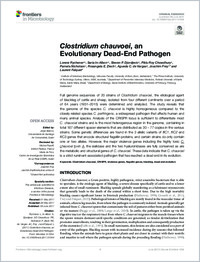Clostridium chauvoei, an evolutionary dead-end pathogen
- Rychener, Lorenz Institute of Veterinary Bacteriology, Vetsuisse Faculty, University of Bern, Switzerland
- In-Albon, Saria Institute of Veterinary Bacteriology, Vetsuisse Faculty, University of Bern, Switzerland
- Djordjevic, Steven P. The iThree Institute, University of Technology Sydney, Ultimo, NSW, Australia
- Nicholson, Pamela Institute of Veterinary Bacteriology, Vetsuisse Faculty, University of Bern, Switzerland
- Chowdhury, Piklu Roy The iThree Institute, University of Technology Sydney, Ultimo, NSW, Australia
- Ziech, Rosangela E. Department of Preventive Veterinary Medicine, Federal University of Santa Maria, Brazil
- Vargas, Agueda C. de Department of Preventive Veterinary Medicine, Federal University of Santa Maria, Brazil
- Frey, Joachim Institute of Veterinary Bacteriology, Vetsuisse Faculty, University of Bern, Switzerland
- Falquet, Laurent Department of Biology, Swiss Institute of Bioinformatics, University of Fribourg, Switzerland
-
09.06.2017
Published in:
- Frontiers in Microbiology. - 2017, vol. 8, p. 1054
English
Full genome sequences of 20 strains of Clostridium chauvoei, the etiological agent of blackleg of cattle and sheep, isolated from four different continents over a period of 64 years (1951–2015) were determined and analyzed. The study reveals that the genome of the species C. chauvoei is highly homogeneous compared to the closely related species C. perfringens, a widespread pathogen that affects human and many animal species. Analysis of the CRISPR locus is sufficient to differentiate most C. chauvoei strains and is the most heterogenous region in the genome, containing in total 187 different spacer elements that are distributed as 30 – 77 copies in the various strains. Some genetic differences are found in the 3 allelic variants of fliC1, fliC2 and fliC3 genes that encode structural flagellin proteins, and certain strains do only contain one or two alleles. However, the major virulence genes including the highly toxic C. chauvoei toxin A, the sialidase and the two hyaluronidases are fully conserved as are the metabolic and structural genes of C. chauvoei. These data indicate that C. chauvoei is a strict ruminant-associated pathogen that has reached a dead end in its evolution.
- Faculty
- Faculté des sciences et de médecine
- Department
- Département de Biologie
- Language
-
- English
- Classification
- Biological sciences
- License
-
License undefined
- Identifiers
-
- RERO DOC 305031
- DOI 10.3389/fmicb.2017.01054
- Persistent URL
- https://folia.unifr.ch/unifr/documents/305956
Statistics
Document views: 119
File downloads:
- pdf: 189
